10+ SAMPLE Security Agreement
-

Security Deposit Agreement Template
download now -

Security Compliance Agreement Template
download now -
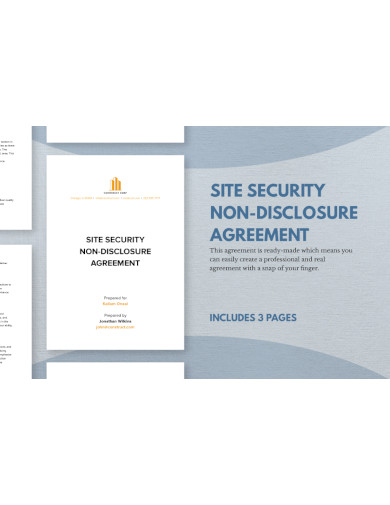
Site Security Non-Disclosure Agreement
download now -

Restaurant Security Agreement Template
download now -

Security Service Level Agreement Template
download now -
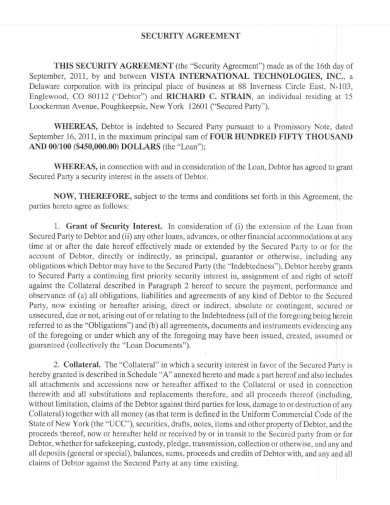
Sample Security Agreement Template
download now -
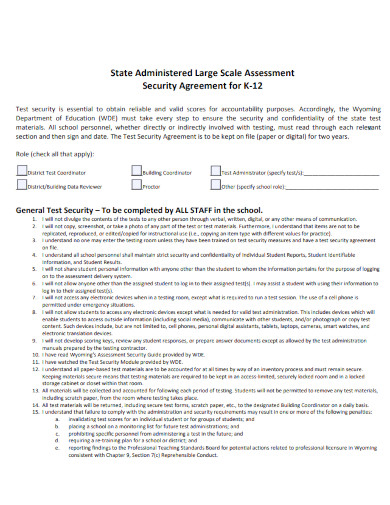
Non-fillable Test Security Agreement
download now -
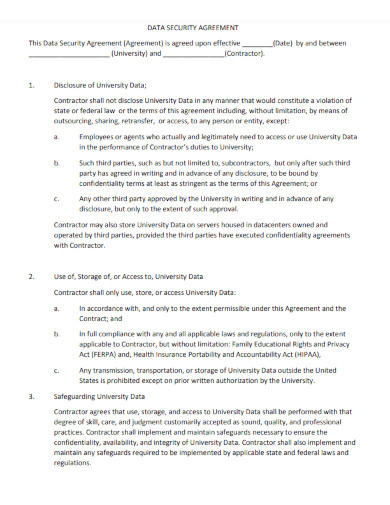
Sample Data Security Agreement
download now -
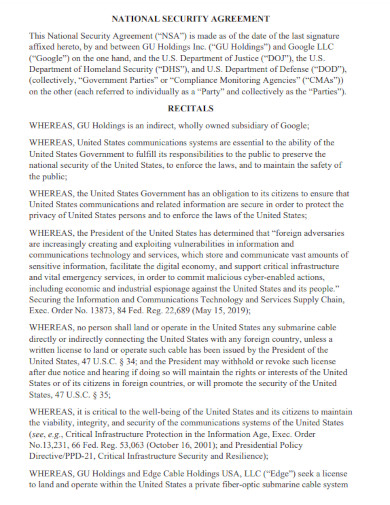
Sample National Security Agreement
download now -
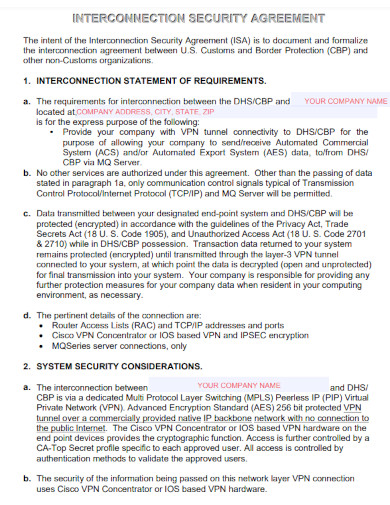
Interconnection Security Agreement Template
download now -
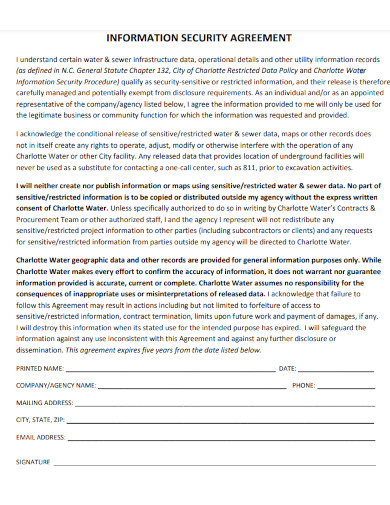
Information Secuirty Agreement Template
download now
What is a security agreement?
Introduction:
A security agreement is a legally binding document that establishes a framework agreement for securing a financial transaction, typically a loan. It serves to protect the interests of a lender by providing a security interest in the borrower’s assets. This comprehensive guide delves into the key components, significance, and intricacies of a security agreement.
Key Elements of a Security Agreement:
Identification of Parties:
Clearly delineate the parties involved—the lender (secured party) and the borrower (debtor)—with their pertinent details.
Description of Collateral:
Specify the assets offered as collateral to secure the loan. These can include real estate, equipment, inventory, accounts
receivable, or any valuable property.
Granting of Security Interest:
Outline the borrower’s explicit grant of a security interest in the identified collateral to the lender. This provision establishes
the lender’s right to seize the collateral in the event of default.
Conditions Precedent:
Detail any conditions or prerequisites that must be met for the security interest to become effective. This ensures clarity
regarding when the security interest attaches to the collateral.
Representations and Warranties:
Include statements made by the borrower regarding the legitimacy and value of the collateral. This provides the lender with
assurance about the quality and condition of the assets.
Covenants:
Specify any actions the borrower must take to maintain the value and condition of the collateral throughout the loan term.
This may include insurance requirements or restrictions on the disposal of assets.
Default and Remedies:
Clearly define the events that constitute a default, empowering the lender to take remedial actions, such as seizing and
selling the collateral to recover the outstanding debt.
Significance of a Security Agreement:
Risk Mitigation:
By securing assets, lenders mitigate the risk associated with lending, providing a level of assurance and reducing the
potential loss in case of default.
Legal Clarity:
The agreement establishes a clear legal relationship between the parties, delineating the rights and obligations of both the
lender and the borrower.
Credit Access:
Offering collateral through a security agreement enhances a borrower’s creditworthiness, potentially facilitating access to
loans with more favorable terms.
Step 1: Title and Introduction
Clearly state that the sample document is a “Security Agreement” at the top. Begin with an introductory paragraph identifying the parties involved and the purpose of the agreement.
Step 2: Define the Parties
Provide the full legal names and addresses of both the lender (secured party) and the borrower (debtor). Clearly establish their roles in the agreement.
Step 3: Description of Collateral
List and describe in detail the assets offered as collateral. This may include real estate, equipment, inventory, accounts receivable, or any other property. Be specific to avoid ambiguity.
Step 4: Granting Security Interest
Clearly state that the borrower grants a security interest in the identified collateral to the lender. Use language that explicitly outlines the conditions under which this security interest is granted.
Step 5: Conditions Precedent
Specify any conditions that must be met for the security interest to become effective. This may include the proper filing of UCC (Uniform Commercial Code) financing statements or other legal requirements.
Step 6: Representations and Warranties
Include statements made by the borrower regarding the legitimacy and value of the collateral. This provides assurance to the lender about the quality and condition of the assets.
Step 7: Covenants
Specify any actions the borrower must take to maintain the value and condition of the collateral throughout the loan term. This may include requirements for insurance, maintenance, or restrictions on asset disposal.
Step 8: Default and Remedies
Define events that constitute a default, such as failure to make payments or breaches of other terms. Clearly outline the remedies available to the lender in case of default, including the right to seize and sell the collateral.
Step 9: Governing Law
Specify the jurisdiction and laws that will govern the agreement. This helps in resolving legal disputes and ensures consistency in interpretation.
Step 10: Signatures and Notarization
Include spaces for the signatures of both parties and any required witnesses. Notarization may be necessary for legal validity.
Step 11: Attachments
Attach any necessary documents, such as sample schedules detailing the collateral or additional terms and conditions.
Step 12: Review by Legal Professionals
Have the agreement reviewed by legal professionals to ensure compliance with local laws and regulations.
Step 13: Execution
Once reviewed and approved, both parties should sign the agreement in the presence of witnesses or a notary public.
What are the key components of a Security Agreement?
A Security Agreement is a crucial legal document, and its effectiveness relies on the clarity and completeness of its key\
components. Here are the essential elements:
1. Identification of Parties:
Clearly state the full legal names and addresses of both parties involved—the lender (secured party) and the borrower (debtor).
2. Description of Collateral:
Provide a detailed list and description of the assets that the borrower is offering as collateral. This may include real estate,
equipment, inventory, accounts receivable, or other valuable property.
3. Granting of Security Interest:
Explicitly state that the borrower grants a security interest in the identified collateral to the lender. This section defines the
lender’s rights over the assets in case of default.
4. Conditions Precedent:
Specify any conditions that must be met for the security interest agreement to become effective. This could include the proper filing of
UCC financing statements or other legal requirements.
5. Representations and Warranties:
Include statements made by the borrower regarding the legitimacy and value of the collateral. This provides assurance to the
lender about the quality and condition of the assets.
6. Covenants:
Specify any actions the borrower must take to maintain the value and condition of the collateral throughout the loan term.
This may include insurance requirements or restrictions on the disposal of assets.
7. Default and Remedies:
Clearly define the events that constitute a default, such as failure to make payments or breaches of other terms. Outline the
remedies available to the lender in case of default, including the right to seize and sell the collateral.
8. Governing Law:
Specify the jurisdiction and laws that will govern the agreement. This helps in resolving legal disputes and ensures
consistency in interpretation.
9. Signatures and Notarization:
Include spaces for the signatures of both parties and any required witnesses. Notarization may be necessary for agreement
of legal validity.
10. Attachments:
Attach any necessary documents, such as schedules detailing the collateral or additional terms and conditions.
Why is a Security Agreement Necessary?
1. Risk Mitigation:
It helps mitigate the risk for lenders by providing them with a security interest in the borrower’s assets. In the event of non
payment or default, the lender has a legal claim to the collateral pledged by the borrower.
2. Ensures Repayment:
The agreement serves as a mechanism to ensure repayment of the loan agreement. If the borrower fails to fulfill their
obligations, the lender can seize and sell the collateral to recover the outstanding debt.
3. Legal Protection:
By establishing a Security Agreement, both parties have a clear understanding of their rights and responsibilities. This legal
document provides a framework for the resolution of disputes and actions in the event of default.
4. Collateral Identification:
It specifies the assets or property that the borrower is pledging as collateral. This clarity helps avoid confusion and ensures
that both parties agree on what assets are securing the loan.
5. Facilitates Borrowing:
For borrowers, having a Security Agreement in place may make it easier to secure a loan. Lenders are more likely to provide
agreement of financing when they have a level of assurance through collateral.
6. Priority in Bankruptcy:
In the event of the borrower’s bankruptcy, a properly executed Security Agreement may give the lender priority over other creditors with unsecured claims.
7. Defines Default Conditions:
The agreement outlines specific conditions or events that constitute a default. This clarity helps prevent misunderstandings and ensures that both parties are aware of the consequences of non-compliance.
8. Flexibility in Collateral Types:
Security Agreements allow for flexibility in the types of assets that can be used as collateral, ranging from real estate and equipment to accounts receivable. This accommodates various types of loans and transactions.
9. Legal Requirement for Certain Transactions:
In some cases, a Security Agreement is a legal requirement, especially in secured transactions involving significant amounts of money or valuable assets.
10. Structured Financial Transactions:
It provides a structured framework for financial transactions, promoting transparency and fair dealing between the parties involved.
How does a Security Agreement differ from a Promissory Note?
Security Agreement and a Promissory Note are distinct legal documents in a lending arrangement, each serving a specific purpose. Here are the key differences between the two:
1. Purpose:
Security Agreement:
Primarily focuses on collateral, Establishes a security interest in specific assets owned by the borrower, Provides the lender with a claim to the collateral in case of default.
Promissory Note:
Emphasizes the borrower’s promise to repay the loan amount, Outlines the terms of repayment, including interest rates and the schedule of payments.
2. Content:
Security Agreement:
Describes the collateral in detail, Specifies the rights of the lender regarding the collateral, Outlines conditions under which the lender can take possession or sell the collateral.
Promissory Note:
Details the amount borrowed, Specifies the interest rate and repayment terms, Includes the borrower’s promise to repay the loan.
3. Focus on Collateral:
Security Agreement:
The primary concern is the security interest in specific assets, The borrower pledges assets to secure the loan.
Promissory Note:
Focuses on the borrower’s commitment to repay, Does not involve specific collateral, though the borrower’s general assets may serve as a source of repayment.
4. Legal Implications:
Security Agreement:
Establishes a legal claim on the collateral, Provides a mechanism for the lender to enforce its rights in case of default.
Promissory Note:
Represents a legally binding promise to repay the loan, Specifies the consequences of non-payment but doesn’t provide a direct claim on specific collateral.
5. Enforcement:
Security Agreement:
Allows the lender to take possession of or sell the collateral to recover the outstanding debt.
Promissory Note:
Generally involves pursuing legal remedies to recover the amount owed.
In conclusion, understanding the significance of a Security Agreement is crucial for borrowers and lenders alike. This legal contract establishes a framework for securing loan agreement by detailing collateral terms. To navigate the complexities, follow this guide on writing Security Agreements. These tips ensure clarity, compliance, and a comprehensive approach, fostering successful lending transactions while protecting the interests of all parties involved.
